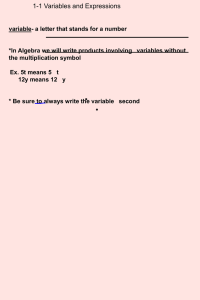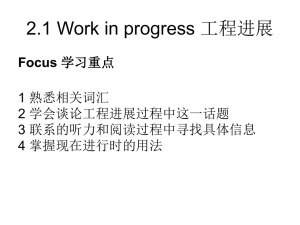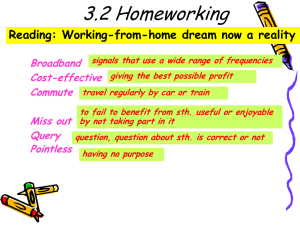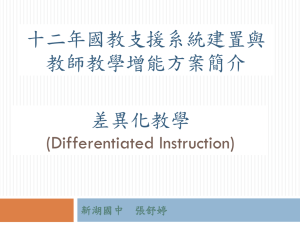7th-Grade-mod-3-les
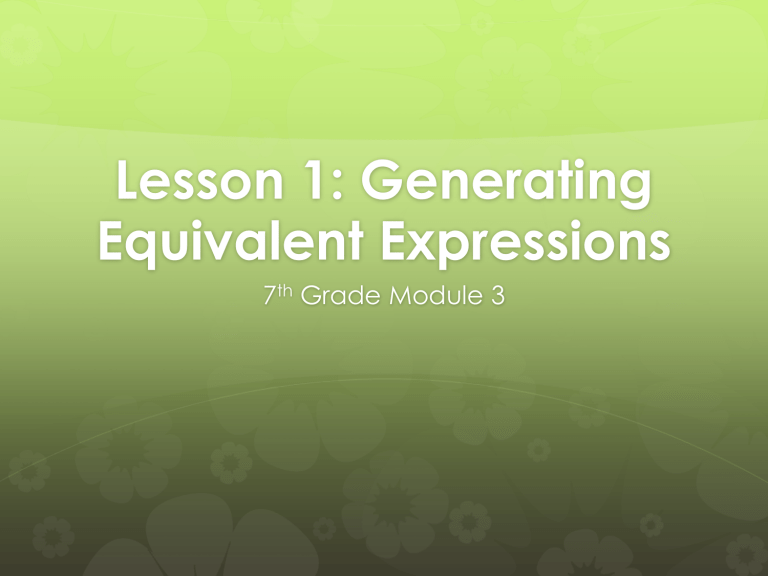
Lesson 1: Generating
Equivalent Expressions
7 th Grade Module 3
Vocabulary
Variable:
A symbol (like a letter) that represents a number. It’s like a placeholder for a number.
Examples: x, y, w are common. 3x=15
Numerical Expression:
A numerical expression is a number, or it is any combination of sums, differences, products, or divisions of numbers that evaluates to a number.
Examples: 3(5) + 2; 8; 15; 3(7–2); 25÷5
Vocabulary
Value of a Numerical Expression:
The value of a numerical expression is the number found by evaluating the expression.
Example: 1 /
3
• (2 + 4) – 7 is a numerical expression. The value of the numerical expression is calculated as –5.
Other words matching this definition:
Number computed
Computation
Calculation
Answer
Simplified value
Vocabulary
Expression
An expression is a numerical expression, or it is the result of replacing some (or all) of the numbers in a numerical expression with variables.
Two ways to “build” an expression:
Start out with a numerical expression and replace one/some of the numbers with letters/variables. 1 /
3
•(2 + 4) – 7; 1 /
3
•(x + 4) – 7
Create an expression like x + x(y – z) and realize that if numbers are placed in it for the variables the result would be a numerical expression.
Vocabulary
Equivalent Expressions: Two expressions are
equivalent if both expressions evaluate to the same number.
Examples: 5(x+3)+4 and 5x + 15 + 4
Expression in Expanded Form: An expression that is written as sums (and/or differences) of products whose factors are numbers, variables, or variables raised to whole number powers.
Examples: 5x + 15 + 4; 8, 3x, x, 7x + 2x + 4 + 3
Vocabulary
Expression in Standard Form:
An expression that is in expanded form where all like terms have been collected.
(Simplified expression).
Example: 5x + 19; 9x + 7
Opening Exercise – a
t = number of triangles. q = number of quadrilaterals.
Write an expression using t and q that represents the total number of sides in your envelope. Explain what the terms in your expression represent.
3t + 4q
Triangles have 3 sides, so there will be 3 sides for each triangle in the envelope. This is represented by 3t.
Quadrilaterals have 4 sides, so there will be 4 sides for each quadrilateral in the envelope This is represented by 4q.
Added together we have the total number of sides.
Opening Exercise – b
t = number of triangles. q = number of quadrilaterals.
You and your partner have the same number of triangles and quadrilaterals in your envelopes. Write an expression that represents the total number of sides that you and your partner have. Write more than one expression to represent this total.
What did you get?
Opening Exercise – c
Each envelope in the class has the same number of triangles and quadrilaterals. Write an expression that represents the total number of of sides in the room.
We have 15 students in this class.
15(3t + 4q)
Opening Exercise – d
Use the given values of t and q and your expression from part a to determine the number of sides that should be found in your envelope.
3t + 4q
t = 4 q = 2
Opening Exercise – e
Use the same values for t and q and your expression from part b to determine the number of sides that should be contained in your envelope and your partner’s envelope combined.
Opening Exercise – f
Use the same values for t and q and your expression from part c to determine the number of sides that should be contained in all of the envelopes combined envelope combined.
Opening Exercise – g
What do you notice about the various expressions in parts e and f?
Example 1: a. Any Order, Any
Grouping Property with Addition
Rewrite 5x + 3x and 5x – 3x by combining like terms.
Write the original expressions and expand each term using addition. What are the new expressions equivalent to?
5x + 3x = x + x + x + x + x + x + x + x = 8x
5x – 3x = x + x + x + x + x = 2x
Example 1: b. Any Order, Any
Grouping Property with Addition
Find the sum of 2x + 1 and 5x
( 2x + 1 ) + 5x original expression
2x + ( 1 + 5x ) Associative property of addition
(any grouping)
2x + ( 5x + 1 ) Commutative property of addition
(any order)
( 2 x + 5 x) + 1 Associative property of addition
( 2 + 5 )x + 1 Combined like terms -Distributive property
7x + 1 Equivalent expression to the given problem
Example 1: c. Any Order, Any
Grouping Property with Addition
(
Find the sum of –3a + 2 and 5a – 3
–3a + 2 ) + ( 5a – 3
–3a + 2 + 5a + ( –3 )
–3a + 5 a + 2 + ( –3 )
2a + ( –1 )
) Original expression
Add the opposite-additive inverse any order, any grouping
Combine like terms – not simplified
2a – 1 adding the inverse is subtracting
Example 3: Any Order, Any Grouping in Expressions with Addition and
Multiplication
3 ( 2 x)
( 3 • 2 )x
6x
4 y( 5 )
( 4 • 5 )y
20y
4 • 2 •z
( 4 • 2 )z
8z
3 ( 2 x) + 4 y( 5 )
( 3 • 2 )x + ( 4 • 5 )y
6x + 20y
3 ( 2 x) + 4 y( 5 ) + 4 • 2 •z
( 3 • 2 )x + ( 4 • 5 )y + ( 4 • 2 )z
6x + 20y + 8z
Example 3: Any Order, Any Grouping in Expressions with Addition and
Multiplication
Alexander says that 3x + 4y is equivalent to
(3)(4) + xy because of any order, any grouping. Is he correct?
3x + 4y 3•4 + xy
Summary
We can use any order, any grouping of terms with multiplication and addition.
They are both associative and commutative.
When you move or group them the value of the answer is not changed.
With subtracting we need to change to addition by adding the inverse (opposite).
Problem Set Examples
Write an equivalent expression by combining like terms. Verify the equivalence of your expression and the given expression by evaluating each for the given values: a=2, b=5, c= –3.
1.
3a + 5a
Combine like terms: 8a
Plug in given values for variable and calculate:
8(2) = 16
3(2) + 5(2) = 6 + 10 = 16
Problem Set Examples
Use any order, any grouping to write equivalent expressions by combining like terms. Then, erify the equivalence of your expression to the given expression by evaluating for the values given in each problem.
10.
3(6a); for a = 3
Combine like terms:
(3•6)a = 18a
Evaluate for given value:
Substitute into 18a: 18( 3 ) = 54
Substitute into 3(6a): 3(6• 3 )
Homework
Do your exit ticket!
Homework is PS for lesson 1

